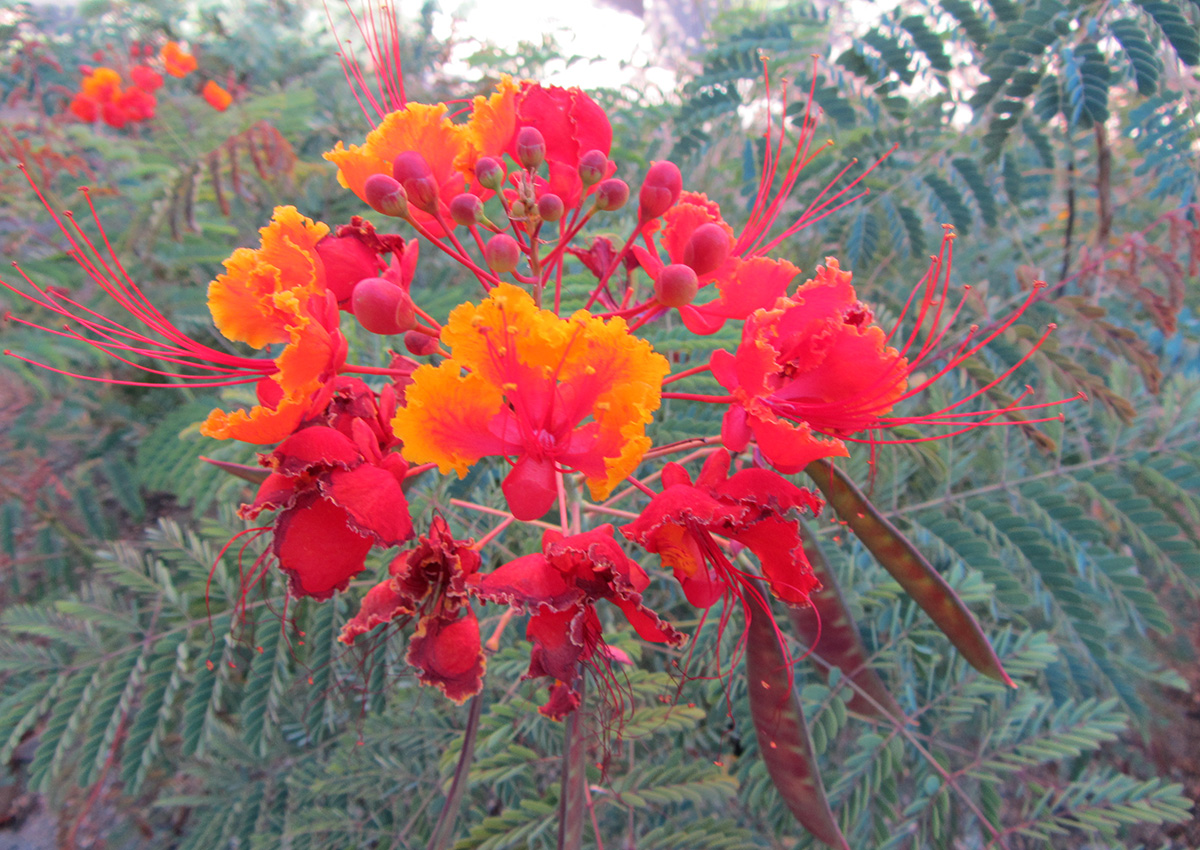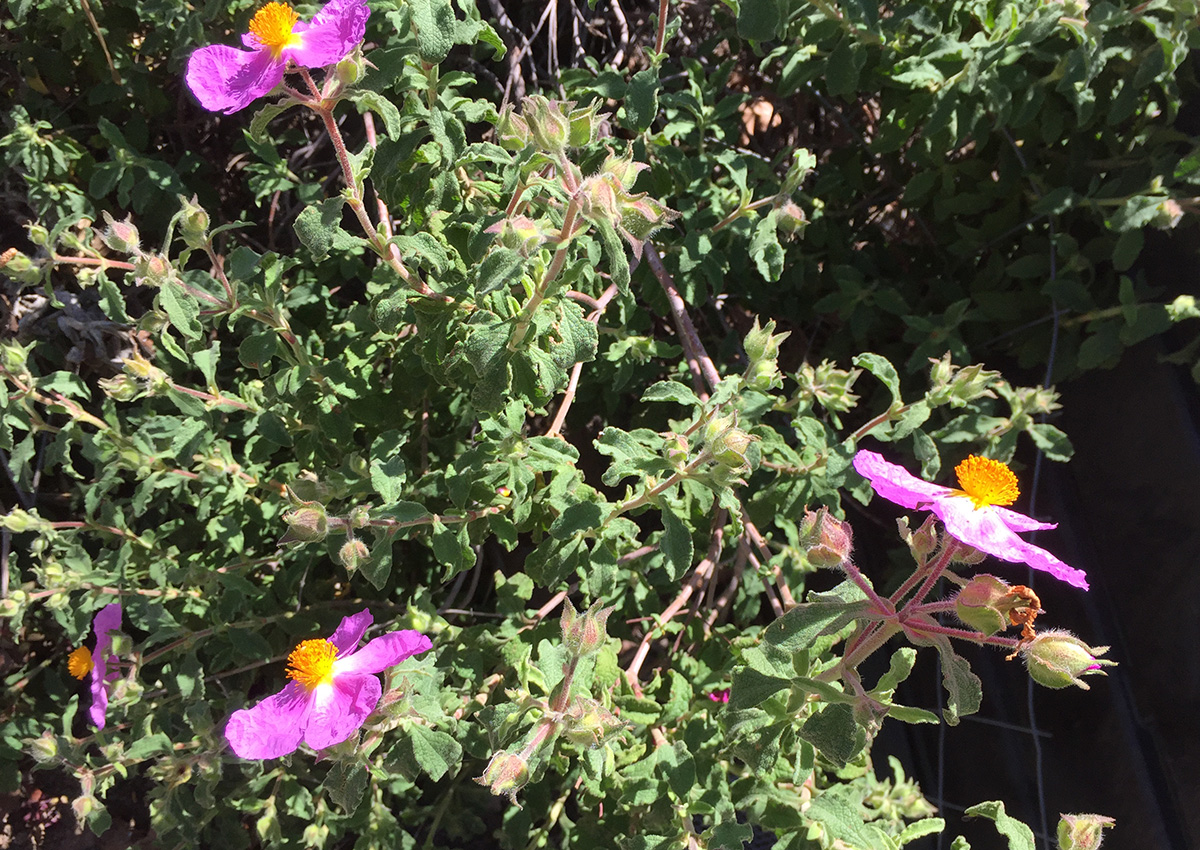
Even if we have a wonderful year of rainfall, we need to rethink our Southern California gardens. It’s likely we will have many dry, hot years ahead. So let’s use this time to plant wisely. Here are some beautiful shrubs that will add glamor to any garden while demanding little from our challenged environment (and our water bills!). All of these plants grow well in Zones 8-11.

Caesalpinias are brilliant bloomers with hot-colored flowers
Species of Caesalpinia (Zones 8–11) offer spectacular flowers. Desert bird of paradise (C. gilliesii, Zones 8–11) is your best bet for the dry, hot interior of Southern California with its barren soil. The brilliant red bird of paradise (C. pulcherrima, Zones 9–11), also called pride of Barbados, can handle light frost and very high heat, but it prefers a tad more moisture and a slightly richer soil than desert bird of paradise does. Although these caesalpinias grow larger in ideal conditions, expect both of these shrubs to spread roughly 4 to 5 feet wide and to top out at 5 to 7 feet tall.

Rock roses come in a variety of flower colors, staying low and spreading wide
Rock roses (Cistus spp. and cvs., Zones 8–11) are good performers in Southern California and would love to be planted in your garden in late autumn. Most varieties thrive in poor soil, have low water needs, and come in a wide selection of growth habits and colors.
For eye-catching magenta flowers, you can’t do better than ‘Sunset’ rock rose (C. × pulverulentus ‘Sunset’, Zones 8–11). This is a tough shrub whose habit varies with local conditions but pretty much stays low and spreads wide, growing roughly 2 to 3 feet tall and 6 feet wide. This adaptable plant will thrive all across Southern California.
‘Little Miss Sunshine’ has daisy-like flowers that pop against variegated foliage. Video: Jane Gates
Another favorite rock rose of mine is ‘Little Miss Sunshine’ (C. ‘Little Miss Sunshine’, Zones 8–11). It prefers a little more water than many of the other rock rose varieties but is still drought tolerant. Due to the leaf variegation, it can handle a bit more shade, too, especially in the hottest areas. But it’s still not a shrub for shady spots. The yellow leaf variegation strengthens with sunshine. Soil amendments are unnecessary; it isn’t fussy. ‘Little Miss Sunshine’ stays low at 2 feet tall and 5 feet wide, making it a fine, woody ground cover.
Rock roses also burn slowly, which makes them good choices for fire-resistant landscaping.

Matilija poppy is a knockout native that demands room to grow
Matilija poppy (Romneya coulteri, Zones 7–10), also known as California tree poppy, is a reliable conversation piece with huge, papery white flowers with yellow centers. Water it occasionally, or let it bask in the sun. The one thing it doesn’t like is having its roots disturbed. Even in my own garden I tried it in multiple positions where it refused to grow, until I forgot about it and left it in a pot on top of a cement ditch. It decided that that was the perfect spot. If you’ve got a decent patch of land for it to fill, this bold, 6-foot-tall California native can spread up to 20 feet wide with its energetic rhizomes.
‘Robyn Gordon’ grevillea has bright red flowers that contrast well with its light green foliage. Both the foliage and flowers come to life when shaking in the wind. Video: Jane Gates
‘Robyn Gordon’ grevillea has feathery foliage and bottlebrush flowers
Australia has a climate similar to that of much of Southern California. Some of Australia’s woody plants do well here without being invasive. Grevilleas (Grevillea spp. and cvs., Zones 9–11) range in size and habit from decorative ground covers to lofty trees. I like the low-growing, ground-cover varieties, but I can’t help being fascinated by the curious, colorful, curly flower petals of ‘Robyn Gordon’ grevillea (Grevillea ‘Robyn Gordon’, Zones 9–11). This plant grows 4 feet tall and 8 feet wide. Avoid phosphorus if you choose to fertilize, although fertilizers aren’t necessary for this plant. Grevilleas have specialized root systems already adapted to poor soil like ours!

Feathery cassia lights up in midwinter
Another Australian native that has become popular due to its ease of care and sunny flowers is feathery cassia (Senna artemisioides, Zones 8–11), also called wormwood senna. It grows 3 to 6 feet tall and just as wide (although occasionally larger in ideal conditions). Hailing from South Australia, this evergreen forms a spherical head of feathery foliage that smothers itself with brilliant yellow, round flowers in winter when nothing else in the garden can compete.
These are just some of the showy shrubs that can create an interesting and colorful foundation for your garden. They will look decorative yet thrive as our climate gets hotter and has more periods of drought. Plant them in fall and winter so they can settle in before next year’s heat arrives!
—Jane Gates is the owner of Gates & Croft Horticultural Design in Los Angeles and is the author of All the Garden’s a Stage: Choosing the Best Performing Plants for a Sustainable Garden.


















Comments
Log in or create an account to post a comment.
Sign up Log in